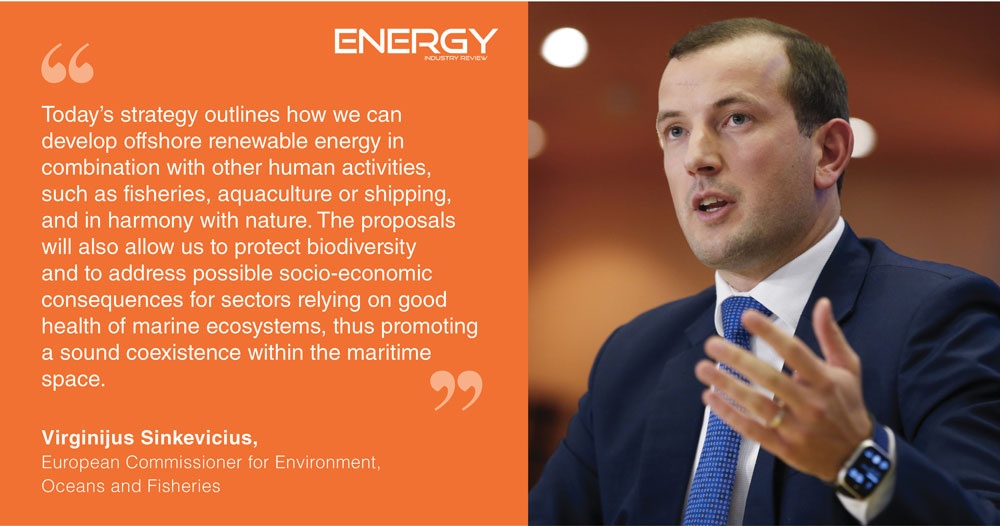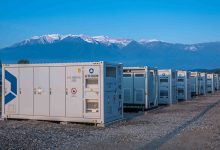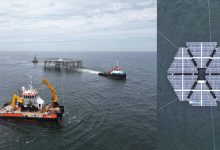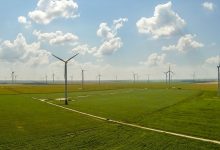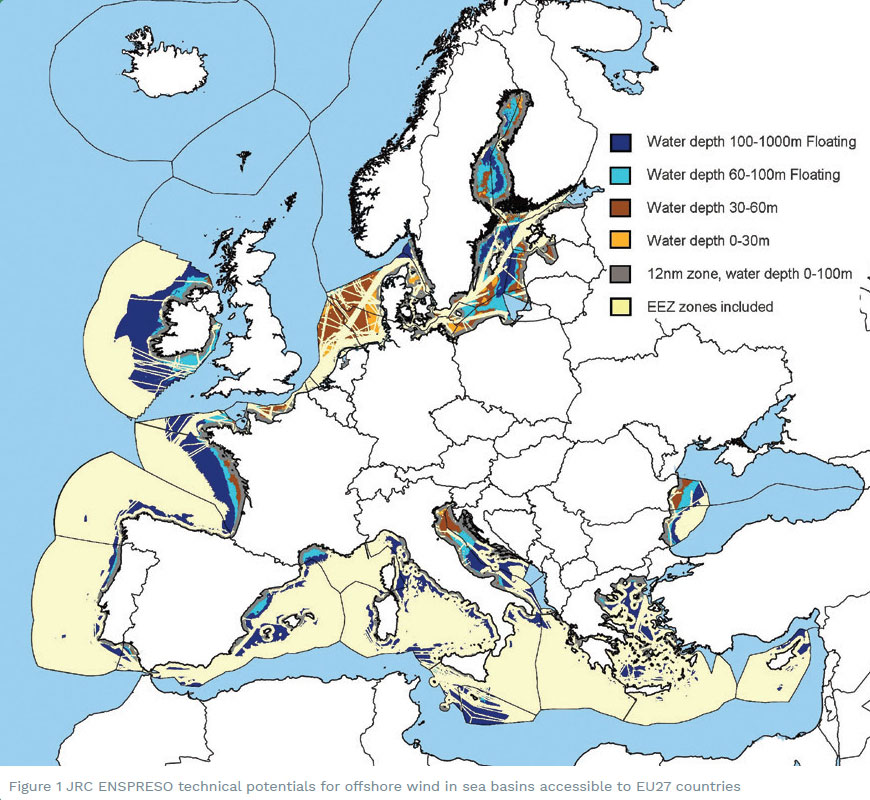Boosting Offshore Renewable Energy for a Climate Neutral Europe
To help meet the EU’s goal of climate neutrality by 2050, the European Commission presented on November 19 the EU Strategy on Offshore Renewable Energy. The Strategy proposes to increase Europe’s offshore wind capacity from its current level of 12 GW to at least 60 GW by 2030 and to 300 GW by 2050. The Commission aims to complement this with 40 GW of ocean energy and other emerging technologies such as floating wind and solar by 2050.
This ambitious growth will be based on the vast potential across all of Europe’s sea basins and on the global leadership position of EU companies in the sector. It will create new opportunities for industry, generate green jobs across the continent, and strengthen the EU’s global leadership in offshore energy technologies. It will also ensure the protection of our environment, biodiversity, and fisheries.
“Today’s strategy shows the urgency and opportunity of ramping up our investment in offshore renewables. With our vast sea basins and industrial leadership, the European Union has all that it needs to rise up to the challenge. Already, offshore renewable energy is a true European success story. We aim to turn it into an even greater opportunity for clean energy, high quality jobs, sustainable growth, and international competitiveness,” Executive Vice-President for the European Green Deal, Frans Timmermans said.
“Europe is a world leader in offshore renewable energy and can become a powerhouse for its global development. We must step up our game by harnessing all the potential of offshore wind and by advancing other technologies such as wave, tidal and floating solar. This Strategy sets a clear direction and establishes a stable framework, which are crucial for public authorities, investors, and developers in this sector. We need to boost the EU’s domestic production to achieve our climate targets, feed the growing electricity demand and support the economy in its post-Covid recovery,” Commissioner for Energy, Kadri Simson, added.
“Today’s strategy outlines how we can develop offshore renewable energy in combination with other human activities, such as fisheries, aquaculture or shipping, and in harmony with nature. The proposals will also allow us to protect biodiversity and to address possible socio-economic consequences for sectors relying on good health of marine ecosystems, thus promoting a sound coexistence within the maritime space,” Commissioner for Environment, Oceans and Fisheries, Virginijus Sinkevičius, mentioned.
To promote the scale-up of offshore energy capacity, the Commission will encourage cross-border cooperation between Member States on long term planning and deployment. This will require integrating offshore renewable energy development objectives in the National Maritime Spatial Plans which coastal states are due to submit to the Commission by March 2021. The Commission will also propose a framework under the revised TEN-E Regulation for long-term offshore grid planning, involving regulators and the Member States in each sea basin.
The Commission estimates that investment of nearly EUR 800 billion will be needed between now and 2050 to meet its proposed objectives. To help generate and unleash this investment, the Commission will:
- Provide a clear and supportive legal framework. To this end, the Commission also clarified the electricity market rules in an accompanying Staff Working Document and will assess whether more specific and targeted rules are needed. The Commission will ensure that the revisions of the State aid guidelines on energy and environmental protection and of the Renewable Energy Directive will facilitate cost-effective deployment of renewable offshore energy.
- Help mobilize all relevant funds to support the sector’s development. The Commission encourages Member States to use the Recovery and Resilience Facility and work together with the European Investment Bank and other financial institutions to support investments in offshore energy through InvestEU. Horizon Europe funds will be mobilized to support research and development, particularly in less mature technologies.
- Ensure a strengthened supply chain. The Strategy underlines the need to improve manufacturing capacity and port infrastructure and to increase the appropriately skilled workforce to sustain higher installation rates. The Commission plans to establish a dedicated platform on offshore renewables within the Clean Energy Industrial Forum to bring together all actors and address supply chain development.
Offshore renewable energy is a rapidly growing global market, notably in Asia and the United States, and provides opportunities for EU industry around the world. Through its Green Deal diplomacy, trade policy and the EU’s energy dialogues with partner countries, the Commission will support global uptake of these technologies.
To analyze and monitor the environmental, social and economic impacts of offshore renewable energy on the marine environment and the economic activities that depend on it, the Commission will regularly consult a community of experts from public authorities, stakeholders and scientists. The Commission has also adopted a new guidance document on wind energy development and EU nature legislation.
EU’S sea basins: A vast and varied potential to deploy offshore renewables
The EU has the largest maritime space in the world and is in a unique position to develop offshore renewable energy thanks to the variety and complementarity of its sea basins.
Regional cooperation has recently been stepped up in some sea basins, with the North Seas Energy Cooperation (NSEC) providing the most advanced example and reference point for other Member States willing to tap the full potential of offshore renewable energy. Offshore renewable energy is now a pan-European priority and cooperation at regional level is being extended to all sea basins and to all Member States. The work ongoing in the Baltic Energy Market Interconnection Plan (BEMIP) or the High-Level Group for south-west Europe on interconnections and the Central and South Eastern Europe Energy Connectivity (CESEC) is very relevant in this context. In June 2020, the Memorandum of Split focused on offshore renewable energy in the context of work to achieve an energy transition in the islands.
The North Sea has a high and widespread natural potential for offshore wind energy thanks to shallow waters and localised potential for wave and tidal energy. The North Sea is currently the world’s leading region for deployed capacity and expertise in offshore wind. It has a solid political and governance foundation with the NSEC. It also benefits from the expertise of organisations such as the OSPAR Convention, which brings together 15 governments and the EU to cooperate on the protection of the marine environment in the North-East Atlantic.
The Baltic Sea also has a high natural potential for offshore wind energy and some localised potential for wave energy. Countries have started to cooperate more closely to tap this potential, including in the Baltic Energy Market Interconnection Plan (BEMIP) High-Level Group, the ‘Vision And Strategies Around the Baltic Sea’ initiative (VASAB), the Baltic Marine Environment Protection Commission, (Helsinki Commission – HELCOM), and the EU strategy for the Baltic Sea Region.
The EU’s Atlantic Ocean has a high natural potential for both bottom-fixed and floating offshore wind energy and good natural potential for wave and tidal energy. Member States are developing a strong pipeline of demonstration projects, building upon years of experience from installed and grid connected equipment and a world-leading network of test centres. The EU’s Atlantic strategy and the 2020 revised Atlantic action plan identify offshore renewable energy as a strategic area for cooperation. France, Spain, and Portugal have also established good regional cooperation in the High-Level Group for south-west Europe on interconnections.
The Mediterranean Sea has a high potential of offshore wind energy (mostly floating), and good potential for wave energy and localised potential for tidal energy. Regional cooperation on offshore renewables is organised under the Barcelona Convention (environment) and the WestMed initiative. Recently, the MED7 Alliance also specifically referred to support for the development of offshore renewable energy in the Mediterranean Sea and in the Atlantic. The Central and South Eastern Europe Energy connectivity (CESEC) High-Level Group could foster regional cooperation initiatives, from the Adriatic Sea eastward.
The Black Sea offers a good natural potential for offshore wind (bottom-fixed and floating) and localised potential for wave energy. Regional cooperation already takes place in the context of the Common Maritime Agenda for the Black Sea. The Black Sea strategic research and innovation agenda lists as one of its priorities to stimulate emerging blue economy sectors, such as offshore wind and wave technology. The CESEC High-Level Group could also foster regional cooperation initiatives in the Black Sea.
EU islands have large potential in marine energies and can play important role in the EU’s offshore energy development. They provide attractive testing and demonstration grounds for innovative offshore electricity generation technologies. The Clean Energy for EU Islands Initiative provides a long term cooperation framework to promote replicable and scalable projects with funding from private sector investors, relevant EU support instruments, and technical assistance, in order to accelerate clean energy transition on all EU islands.
In addition, many European outermost regions and overseas countries and territories have a good potential for offshore renewable energy and are pioneers in decarbonising islands, which are included in the Clean Energy for EU Islands Initiative. New initiatives, including cooperation with neighbouring regions when possible, should help optimise this potential.
Background
Offshore wind produces clean electricity that competes with, and sometimes is cheaper than, existing fossil fuel-based technology. European industries are fast developing a range of other technologies to harness the power of our seas for producing green electricity. From floating offshore wind, to ocean energy technologies such as wave and tidal, floating photovoltaic installations and the use of algae to produce biofuels, European companies and laboratories are currently at the forefront.
The Offshore Renewable Energy Strategy sets the highest deployment ambition for offshore wind turbines (both fixed-bottom and floating), where commercial activity is well advanced. In these sectors, Europe has already gained unrivalled technological, scientific, and industrial experience and strong capacity already exists across the supply chain, from manufacturing to installation.
While the Strategy underlines the opportunities across all of the EU’s sea basins – the North Sea, the Baltic Sea, the Black Sea, the Mediterranean and the Atlantic – and for certain coastal and island communities, the benefits of these technologies are not limited to coastal regions. The Strategy highlights a broad range of inland areas where manufacturing and research is already supporting offshore energy development.



